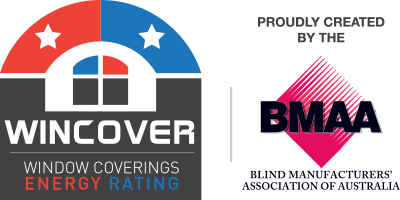What is U-value?
The U-value measures how well a material or assembly prevents heat from passing through it. U-value ratings in WincovER are for a whole window assembly which includes the shading layer and a typical window, and are indicated Uw. U-value ratings generally fall between 2.0-10.0 W/m2.K for Australian products. WincovER certified products with a lower U-value will prevent more heat from escaping a warm room in winter and should be considered if concerned about heating costs. A low U-value is also of benefit in summer because less unwanted heat enters the home.
Is an R-value the same as a U-value?
R-value and U-value are essentially two sides of the same coin. The two are actually inversely related. R-value is the term usually used to rate the insulation value of walls, floors and ceilings. The higher the R-value, the better insulated are the walls and ceilings. U-value is usually used to describe the insulation value of windows. The lower the U-value the better job a window, window covering or outdoor shade does in keeping out the heat and cold.
What does Solar Heat Gain Co-efficient (SHGC) mean?
SHGC measures how well a product blocks radiant heat caused by sunlight. The SHGC is the fraction of incident solar radiation admitted through a window covering or outdoor shade fitted to a window, both directly transmitted, and absorbed and subsequently released inward. SHGC is expressed as a number between 0 and 1. WincovER certified products with lower SHGC means there is less heat gain, which may reduce cooling costs, while products with higher SHGC means there is more heat gain, which may reduce heating costs in winter but increase the risk of overheating and higher cooling bills in summer.
What is Visible Transmittance (VT)?
Visible transmittance is an optical property that measures how much visible light comes in through a product. VT is expressed as a number between 0 and 1. The higher the number, the more light is transmitted. A VT of 0 (zero) means no light is admitted. In contrast, an open hole in the wall, with no window, has a VT of 1.
If I have air conditioning, do I need window coverings or outside shades?
When aiming to resolve thermal comfort issues it is best to install efficient window coverings and external shades rather than rely solely on heating, ventilation and air conditioning (HVAC). Energy efficient window coverings and outside shades help keep indoor temperatures warmer in winter and cooler in summer, helping to lower the costs of running even the most efficient HVAC systems.
In cooler climates, look for window coverings and outdoor shades with low U-values in order to minimise discomfort caused by cold windows. At the same time, a higher SHGC provides more free heating from the sun, especially in midwinter.
In warmer climates look for lower SHGC values, preferable with a lower U-value if possible. WincovER’s heating and cooling stars account for all these effects and make the selection of the right product easier for the homeowner.
Will WincovER tell me how much energy I will save?
WincovER does not measure exactly how much energy can be saved. WincovER rates the relative annual energy impact of blinds, awnings, louvres and shutters in a whole-of-house situation in Australia. WincovER can be used to compare the energy performance of the material used: fabric, slat or louvre, using a 10 star rating system for easy comparison. For a particular material, a WincovER rating also shows the percentage improvement in annual energy performance of the entire window assembly (window + window covering or outdoor shade) when compared with a window that has no window covering or outdoor shade at all. This rating is based on the simulated energy use of a model house in a single location; your actual energy savings will depend on how your house is constructed, your location, the size and orientation of your windows and other factors.

